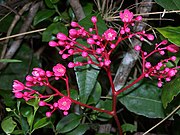
This is a list of the endemic flora of Puerto Rico . This list is sorted in alphabetical order by plant family and binomial names. [1]
Contents
- Acanthaceae
- Amaryllidaceae
- Apocynaceae
- Aquifoliaceae
- Araceae
- Araliaceae
- Asparagaceae
- Aspleniaceae
- Asteraceae
- Begoniaceae
- Bignoniaceae
- Boraginaceae
- Bromeliaceae
- Buxaceae
- Cactaceae
- Campanulaceae
- Canellaceae
- Celastraceae
- Clusiaceae
- Cyatheaceae
- Cyperaceae
- Dioscoreaceae
- Ebenaceae
- Ericaceae
- Euphorbiaceae
- Fabaceae
- Gentianaceae
- Gesneriaceae
- Lamiaceae
- Lauraceae
- Loranthaceae
- Magnoliaceae
- Malpighiaceae
- Malvaceae
- Marcgraviaceae
- Melastomataceae
- Meliaceae
- Myricaceae
- Myrtaceae
- Oleaceae
- Orchidaceae
- Passifloraceae
- Pentaphylacaceae
- Phyllanthaceae
- Piperaceae
- Poaceae
- Polygalaceae
- Polygonaceae
- Polypodiaceae
- Portulacaceae
- Primulaceae
- Pteridaceae
- Rhamnaceae
- Rubiaceae
- Rutaceae
- Sabiaceae
- Salicaceae
- Santalaceae
- Sapindaceae
- Sapotaceae
- Schizaeaceae
- Schoepfiaceae
- Selaginellaceae
- Simaroubaceae
- Solanaceae
- Styracaceae
- Symplocaceae
- Thymelaeaceae
- Urticaceae
- Verbenaceae
- Zamiaceae
- See also
- Notes
- References
- Further reading
- External links


